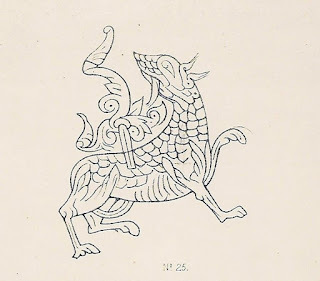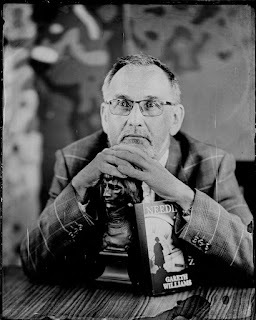Virginia Crow's Blog: Crowvus Book Blog, page 17
November 24, 2023
Masterworks: The Lacemaker's Son - Melissa Speed - Interview
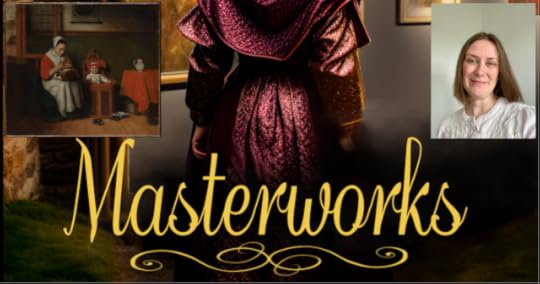
Today is the fourth of a series on nine interviews I'm sharing on the Crowvus Book Blog. These are from the authors of the short stories included in the Masterworks anthology by the Historical Writers Forum. We're running through chronologically, some are video interviews, others are written.
Our first video interview! Here is the lovely Melissa Speed to share a little bit about her writing, artwork, and reenacting, as well as the inspiration behind her powerful story, The Lacemaker's Son...
Or you can watch the interview in YouTube here!You can find The Lacemaker's Son in the Masterworks anthology, which is available on #KindleUnlimited HERE!
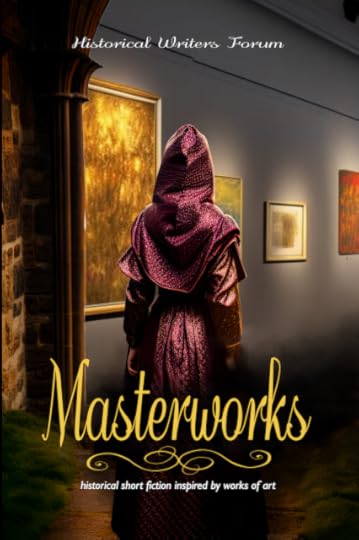
Now, let's meet the author!
 Melissa Speed writes fiction and poetry in addition to her creative non-fiction, personal essays and travel blogging. Much of her work is published on Medium in a variety of publications, including the popular Scribe. Her personal essay I Was Ashamed of My Post-Surgery Body Hair was published in Issue 1 of Aghh! Zine (2022, Brighton, UK). Her historical poem Queen of the Iceni (published in Medium's Share the Love, June 2020) was adapted into a choral work by the American choir Pantera, and she is the winner of a Kids Poetry Club poetry for children competition. She writes a history-themed disabled travel blog at http://www.accessinghistory.com.
Melissa Speed writes fiction and poetry in addition to her creative non-fiction, personal essays and travel blogging. Much of her work is published on Medium in a variety of publications, including the popular Scribe. Her personal essay I Was Ashamed of My Post-Surgery Body Hair was published in Issue 1 of Aghh! Zine (2022, Brighton, UK). Her historical poem Queen of the Iceni (published in Medium's Share the Love, June 2020) was adapted into a choral work by the American choir Pantera, and she is the winner of a Kids Poetry Club poetry for children competition. She writes a history-themed disabled travel blog at http://www.accessinghistory.com.In addition to her writing, Melissa has previously been a beta reader for several historical fiction authors. A volunteer for two heritage trusts, she is also an artist and an avid reader in her spare time.
She lives in Buxton, Derbyshire in the UK.
November 23, 2023
Masterworks: Blood on White Mountain - E.M. Swift - Interview
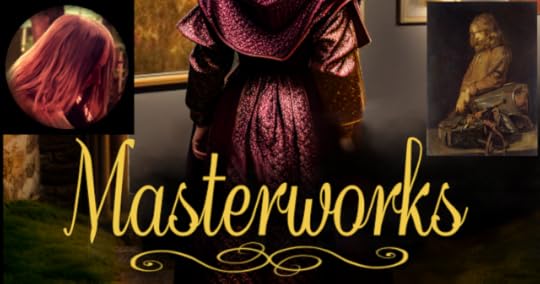
Today is the third of a series on nine interviews I'm sharing on the Crowvus Book Blog. These are from the authors of the short stories included in the Masterworks anthology by the Historical Writers Forum. We're running through chronologically, some are video interviews, others are written.
This Friday, it is my pleasure to welcome E.M. Swift to share a little about her story, Blood on White Mountain, her writing process, and a little bit about her inspiration...
First of all, tell us a little bit about yourself, what you write (besides Masterworks!), and what inspired you to begin writing.
I would love to be able to tell you what inspired me to begin writing, but I truly have no idea. I have written stories for as long as I can remember and maybe even before that. According to my mother, I was writing my tales from the moment I learned to write - and often illustrating them too, albeit with much less success.
It undoubtedly helped that I was encouraged by my mother, who still has some of my very early writing efforts from age four or five. I would take the time to create little books for my (Incredibly short) short stories. Then, at school I had the habit of filling my rough-work book with poems and paragraphs. Far from telling me off for doing so, my school gave me a separate exercise book to write in. I was the only one in my class to be given such a book and that made me realise that there had to be something good about what I was doing.
Unfortunately, I was not able to build on such a promising start. Life intervened as it often does and writing took a back seat to other things for many years.
All that aside, what inspired me to write historical fiction is easier to pin down.
It was a mix of enjoying reading it, inspiration from great authors such as Dorothy Dunnett, and a passion for 17th century history which had been sparked in my university days when I joined the English Civil War Society reenactment group.
-~-
Introduce us to your chosen artwork
The artwork is a painting called ‘Young Soldier’ by Frans Hals Junior. It presently resides in The Hermitage collection. It was painted about thirty years after the time when my story was set, at the end of the war of which my story describes the beginning. It shows a young man, his face mostly concealed by the fall of his long, light brown hair, cradling a musket against his body. On the table beside him are a helmet and cuirass and other items of a soldier’s equipment.
To me it sums up the unbearable burden placed upon so many young men during this turbulent time. White Mountain was the first battle of the Thirty Years War. In those decades millions of young men from across Europe would be like this one, taking up arms and armour to fight each other.
It resonated with me in particular, as one of the characters in my Lord’s Legacy series had been young and in love with just such a youthful soldier at the very start of that conflict.
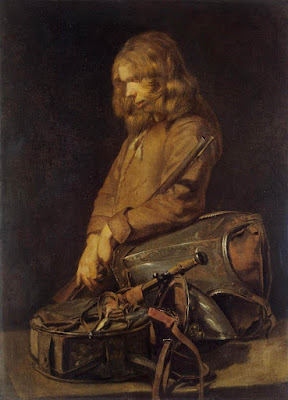
-~-
This story is set amid the conflict for the throne of Bohemia. Which side would you have been on?
The root of the war was religion, so had I lived at the time my support would have depended one hundred present upon my religious affiliation.
From a modern perspective it is always very difficult to unpack the rights and wrongs of such things. Both sides were motivated by values I couldn’t really relate to, however I think the thoroughly modern principle of self-determination might place my broader sympathy with the Bohemians rather than the emperor.
To explain: Bohemia was technically an elective monarchy. However, it had become a given that the king who would be elected each time would be a Habsburg who was also the (elected) Holy Roman Emperor.
When the Emperor Matthias fell ill and named his nephew Ferdinand to be his successor, the Bohemians only agreed to elect him as their king once Ferdinand had promised to uphold their religious freedoms. But it quickly became clear the ferociously Catholic Ferdinand had no intention of doing so. That led to the Bohemians throwing Ferdinand's representatives out of a window in protest, and electing a Protestant prince to be their king instead.
My story looks at the consequences of that act and where it eventually led as well as telling the very personal tale of one young woman caught up in the events.
-~-
The main character, Kate, has a real rollercoaster of a story! If you were in your own story what words of wisdom would you give her at the start?
I’m not sure taking advice is Kate’s strong point!
That said perhaps I’d remind her that one should always take care to obtain a young man’s name and address…
-~-
At the end of Blood on White Mountain you included an Historical Note. How important do you think it is that readers of historical fiction are presented with the facts?
I strongly believe that historical fiction is, and should be, what it says on the can - fiction in a historical setting. An author should be free to write whatever and however they want, to interpret events and historical figures as they choose and insert their own characters into the mix if appropriate. Whatever it takes to make a thundering good story. Not everyone will agree with how an author might interpret events and historical characters, but that should never restrict the author’s fundamental freedom to write what they wish to write.
That said, when a reader’s first encounter with an era is through historical fiction it can shape and even distort their view of the period. That is why I think it is a good idea to provide notes which both establish the full context of the story and make clear where it has in any way breached or overturned the known historical record.
-~-
Have you got a favourite line from Blood on White Mountain of which you felt particularly proud?
There is one point where one of the characters is feeling lost and hopeless and it comes out in the way he speaks:
‘His voice had an edge to it, as if he was witnessing time itself running through a broken hourglass and spilling out into nothing.’I like to think this captures that moment of despair when we feel our very life shattered by a terrible event and running away beyond our control.
-~-
What do you hope readers will take away from your story?
I hope it might offer some insight into the origins of one of the darkest and most brutal wars Europe has ever endured. Also for those who have read or may go on to read my Lord’s Legacy books, it explores the formative experiences of one of the major characters in the series.
-~-
If time travel were possible (perhaps it’s only a matter of time!) would you choose to go back to 1620, or another year? Why?
I would only travel in time if I was certain of my return ticket, and even then I might think twice!
There is a tendency to romanticise the past and not just in fiction. Popular imagination often builds myths around major events or important people which are far from the reality. I think if I could go back to see what really happened I would be disappointed or horrified more often than inspired.
What would inspire me more, perhaps, would be the quiet, day-to-day heroism and resilience of ordinary people trying to live their lives despite the often devastating impact of those great events and the heavy footfall of those prominent people. So perhaps if I could go back on a brief visit to 1620 it would be to see that.
-~-
What’s next for your writing? Any projects in the pipeline?
Amongst other things, I have been working for some time on a series of books set in the midst of the Thirty Years War, covering key historical events both in England and more widely in Europe. I have no idea when this will see the light of day or in what form, but it does tell much more of Kate’s story.
You can find Blood on White Mountain in the Masterworks anthology, which is available on #KindleUnlimited HERE!

Now, let's meet the author!
 Eleanor Swift-Hook enjoys the mysteries of history and fell in love with the early Stuart era at university when she re-enacted battles and living history events with the English Civil War Society. Since then, she has had an ongoing fascination with the social, military and political events that unfolded during the Thirty Years’ War and the Wars of the Three Kingdoms. She lives in County Durham and loves writing stories woven into the historical backdrop of those dramatic times.
Eleanor Swift-Hook enjoys the mysteries of history and fell in love with the early Stuart era at university when she re-enacted battles and living history events with the English Civil War Society. Since then, she has had an ongoing fascination with the social, military and political events that unfolded during the Thirty Years’ War and the Wars of the Three Kingdoms. She lives in County Durham and loves writing stories woven into the historical backdrop of those dramatic times.
November 22, 2023
Masterworks: La Belle Dame sans Merci - Kathleen Guler - Interview
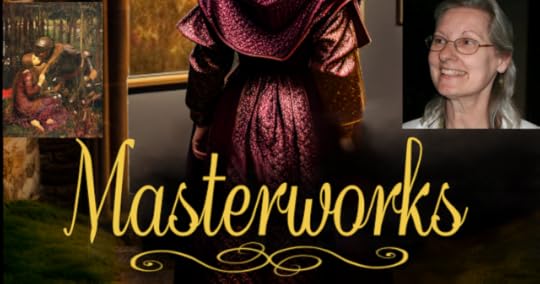
Today is the second of a series on nine interviews I'm sharing on the Crowvus Book Blog. These are from the authors of the short stories included in the Masterworks anthology by the Historical Writers Forum. We're running through chronologically, some are video interviews, others are written.
Here is the brilliant Kathleen Guler, the author of La Belle Dame sans Merci, shedding light on her writing process, her inspiration, and her fantastic story...
First of all, tell us a little bit about yourself, what you write (besides Masterworks!), and what inspired you to begin writing.
Something about me, well…I am such a history nerd! I’ve been immersed in historical fiction since I was a teenager when my mother gave me a novel about Queen Elizabeth I. But then, if you count stories of Zorro in Old California or a John Wayne western, maybe my interest had already been implanted as a little kid. Anything historical appeals to me as long as it is pre-1920 or so. My first round of college (out of three!) reflected this with art history, music history, literature and drama (totally fell in love with Shakespeare after seeing the Zefferelli version of Romeo and Juliet).
Then I discovered Mary Stewart’s Merlin trilogy, which had a list of historical sources for further reading in the back of her novels. That led to stacks of books to study about Arthurian legend and Dark Age history, plus a research trip to the UK where I met the Arthurian scholar Geoffrey Ashe. The result is my four-novel Macsen’s Treasure Series set in fifth-century Britain that portrays a spy’s efforts to help Merlin’s prophecy of the rightful king taking power—Arthur—to come true. Can’t help it, I’m proud the final book in the series, A Land Beyond Ravens, won the 2010 Colorado Book Award.
My fifth novel rotates three interconnected stories that involve a tough warrior-priestess in ancient Scythia, an impulsive, headstrong widow on the run in early medieval Europe, and a suicidal female archaeologist in late nineteenth-century Britain. This book required an enormous amount of research, so I went back to school (this is the third round) and earned my masters degree in history. The university provided great access to otherwise unreachable resources. If I was going to do all that work, I thought I should get credit for it. Recently finished, the novel currently awaits an agent and/or publisher.
-~-
Introduce us to your chosen artwork.
I have always loved John William Waterhouse’s 1893 painting of La Belle Dame sans Merci. A large framed print of it hangs on my wall. It is a fascinating Pre-Raphaelite style depiction of a mysterious young woman in the woods seated on the ground with her legs folded under her like a fawn, a heart embroidered on her sleeve, and all the while pulling a kneeling knight in late medieval armour to her, possibly for a kiss. The mood is dark and brooding with subtle sexual undertones. Is she luring him into some unknown dire fate as suggested in John Keats’s 1820 poem of the same title? Or are these two simply falling in love and enjoying a brief tryst in the woods? Therein lies the inspiration for the story.
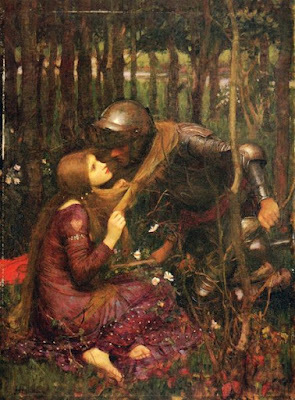
-~-
What was your favourite thing to research for La Belle Dame sans Merci? Did you discover any gems?
Researching this story was quite a journey. I knew Waterhouse had drawn from Keats’s 1820 poem to inspire his images of the characters and setting. I also knew of a much older poem, also of the same title, written by French courtier Alain Chartier in 1424. Because of the style of the painting’s clothing and armour, I decided to focus on France in the year 1424 for the setting.
Since my historical specialty is early medieval British history, I needed to brush up on late medieval French history during the Hundred Years War, which was fought between the French and English, mainly on French soil. I knew the French had an alliance with Scotland that paired them against their mutual enemy, the English, but I did not know how long it had been in place, how formal it was, and that it had a name: The Auld Alliance. This gave me the idea to make William a Scottish soldier and to have the long-standing animosity between the Scots and English play into the story. Jackpot! Then, in the process of this same research, I also discovered the town of Verneuil in Normandy was the site of a battle in August 1424 and the Scots played an important part in it. Double jackpot!
An aside: when I was reading parts of this story to my writing critique group, you should have heard me mangle the French phrases I sprinkled in. I know zero about French, especially pronunciation. Fortunately, one of our members used to be a diplomat in Paris and another is married to a Frenchman. Instant help!
-~-
What were the biggest difficulties in writing about the two cultures across The Auld Alliance in the story? Were there any aspects of the French and Scottish cultures which clashed with one another?
Medieval chroniclers wrote that the French, with their sense of refinement, disliked the Scots almost as much as they did the English. Despite their utter disdain of the Scots’ perceived crudeness, the French needed their fighting prowess, and so put up with them. The French considered them as having ‘vain arrogance and reckless haste.’ This may have been proven true more than once when arrogance and recklessness contributed to losing battles to the English, including Verneuil.
-~-
La Belle Dame sans Merci is written in present tense. What are the biggest pros and cons of writing a story in this style?
I’ve come to like the immediacy of present tense. My four Arthurian novels were all written in a closely held third person, past tense. My fifth book, the one with the three interconnected stories, is all written in first person, present tense like the La Belle Dame story. I know some readers dislike present tense, but I believe that comes down to a matter of personal taste and what feels right for a particular story. Now that I’ve been working in present tense for a while, past tense doesn’t feel comfortable to me anymore.
-~-
Did you have any real people inspirations for William or Isabeau?
Both William and Isabeau are completely fictional. If the couple in the painting, Keats’s poem, or Chartier’s poem were based on real people, I have not been able to establish it. They don’t appear to be part of any literary cycle, either. They very well could have been based on real people given that Chartier was a royal clerk, notary, and financial secretary to the French king, Charles VII. He could have been writing about people at the French court, but without proof, I decided to place the fictional William and Isabeau into a slice of known French history.
-~-
Have you got a favourite line from La Belle Dame sans Merci of which you felt particularly proud?
Here’s a couple:
‘No one can pry memories out of my head to read my mind like a proclamation on parchment.’(Isabeau is afraid someone will discover her actions in the past.)
‘He eyes me with suspicion, as though I might turn him into a toad or some slimy thing that has crawled unnoticed in to the slice of peach the English commander is about to pop into his mouth.’(Isabeau has wandered into a place in the castle where she doesn’t belong.)
I also strategically placed a couple of lines in both the beginning and ending that reflect these lines in Keats’s poem: "The sedge is wither’d from the lake/And no birds sing." The story has a river instead of a lake and my wording is a variation, but the idea is the same and fitting.
-~-
What do you hope readers will take away from your story?
I’d like to know that readers will learn a bit about this episode of the Hundred Years War through the eyes of William and Isabeau. In addition, while the main part of the story takes place in August 1424, Isabeau’s backstory deeply influences her attitude towards William and the grove where she finds her personal sanctuary. She suffered through the horrors of the English siege of Rouen in 1418-1419. When the English threaten to shatter her life again in Verneuil, she must decide: stay or flee. We see this happening in the world yet again today. So many people are still forced to make terrible decisions when there is little or no choice for them. Nothing ever truly changes.
-~-
If time travel were possible (perhaps it’s only a matter of time!) would you choose to go back to 1424, or another year? Why?
That’s a hard question. In one way, yes, I’d like to go back to see if I’ve properly portrayed my characters, their time, and their place. On the other hand, since I invested a great deal of time and research into Arthurian Britain, I think I’d rather go there. And if I find that one of my characters in particular was real, I might not want to come back here!
-~-
What’s next for your writing? Any projects in the pipeline?
Lately I’ve been working on quite a few short stories that are related to each other and plan to create a novel out of them. One was published in a magazine last year, and another has been submitted to another anthology. This is still in the idea stage and not very coherent, but I hope to make it work. Thanks so much for listening!
You can find La Belle Dame sans Merci in the Masterworks anthology, which is available on #KindleUnlimited HERE!

Now, let's meet the author!
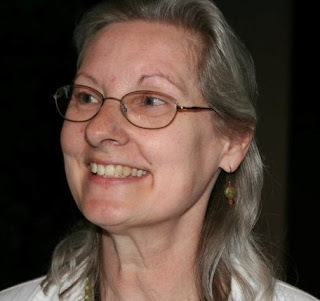 Kathleen Guler is the author of the multi-award winning Macsen’s Treasure Series: four historical novels set in fifth-century Arthurian Britain. The series includes A Land Beyond Ravens, which won the 2010 Colorado Book Award in the historical fiction category. The author has also published numerous articles, essays, short stories, reviews, and poems. Her work has appeared in Goose River Press, Eastern Iowa Review, Steamboat Magazine, and Saber and Scroll Journal, among other publications. She is a member of the Colorado Authors League and the Historical Novel Society. Her fifth novel intertwines a trio of stories revolving around a tough warrior-priestess in ancient nomadic Scythia, an impulsive, headstrong widow on the run in early medieval Europe, and a suicidal female archaeologist in late nineteenth-century Britain. The author lives in the magnificent Colorado Rocky Mountains with her husband, two parakeets, and probably what amounts to the entire county’s bird population.
Kathleen Guler is the author of the multi-award winning Macsen’s Treasure Series: four historical novels set in fifth-century Arthurian Britain. The series includes A Land Beyond Ravens, which won the 2010 Colorado Book Award in the historical fiction category. The author has also published numerous articles, essays, short stories, reviews, and poems. Her work has appeared in Goose River Press, Eastern Iowa Review, Steamboat Magazine, and Saber and Scroll Journal, among other publications. She is a member of the Colorado Authors League and the Historical Novel Society. Her fifth novel intertwines a trio of stories revolving around a tough warrior-priestess in ancient nomadic Scythia, an impulsive, headstrong widow on the run in early medieval Europe, and a suicidal female archaeologist in late nineteenth-century Britain. The author lives in the magnificent Colorado Rocky Mountains with her husband, two parakeets, and probably what amounts to the entire county’s bird population.
November 21, 2023
Masterworks: A Našû for Ilu - Stephanie Churchill - Interview
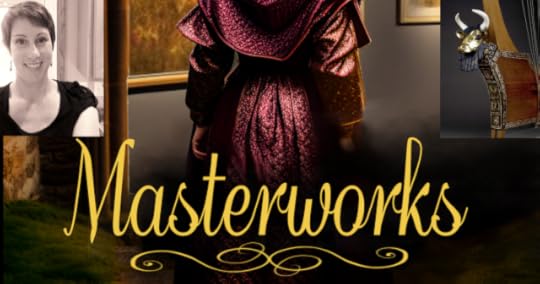
Today is the first of a series on nine interviews I'm sharing on the Crowvus Book Blog. These are from the authors of the short stories included in the Masterworks anthology by the Historical Writers Forum. We're running through chronologically, some are video interviews, others are written.
So, without any further ado, I am delighted to welcome the fabulous Stephanie Churchill, the author of A Našû for Ilu, who is sharing a little insight into her brilliant story...
First of all, tell us a little bit about yourself, what you write (besides Masterworks!), and what inspired you to begin writing.
When you ask this question of writers, I feel like so many of them answer with something like, “I wanted to be a writer since I was a child.” That is definitely not my story. I was a clueless child in the sense that writing stories just never really occurred to me. Telling stories, on the other hand, was my favourite pastime. I was a big daydreamer, was always telling myself escapist tales in my head, falling asleep at night weaving more details into whatever fanciful thing I had actively creating in my imagination. It wasn’t until after I had done practical things with my life like going to school, working in the legal field, and then starting a family that the idea of writing came up.
It took someone with credentials to suggest it or I would never have taken the idea seriously. After writing a ridiculously long review of her book, Sharon Kay Penman, who was my favourite author at the time, asked me: “Have you ever considered writing?” I laughed at first, but the more I thought on it, the more seriously I took the question.
I’ve always loved historical fiction, but Sharon set the bar way too high for me. She was a model showing me what it would take to be serious when writing that genre. I knew I could never do justice to the details the way she did. I’m more interested in telling a story than I am in articulating historical events, so I opted to write what I call historically inspired fiction—books like read like historical fiction but don’t actually contain any real history. I’m really just after telling a good tale.
A Našû for Ilu is my first piece of purely historical fiction.
-~-
Introduce us to your chosen artwork
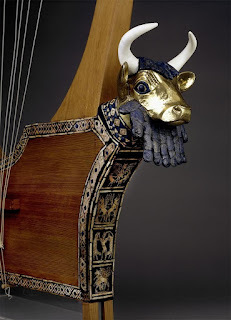
The Bull-headed Lyre of Ur was unearthed in 1926 by British archaeologist Leonard Woolley, during his excavations of the Royal Cemetery at Ur in what is now southern Iraq. It was buried in the tomb of Puabi, a Sumerian queen who lived during the Early Dynastic III period (100-200 years before the setting of my story which takes place during the reign of Šarru-kīn whom we know as Sargon of Akkad, founder of the Akkadian dynasty). Made of gold, silver, lapis lazuli, and shell, the lyre is decorated with intricate carvings and inlays, depicting a variety of scenes from Mesopotamian mythology and everyday life. Since it was buried in the tomb with a queen, it was clearly a highly valued possession.
-~-
A Našû for Ilu centres around music. How much would you say music influences your writing?
To be honest, I don’t know if music influences my writing specifically, though many writers have certain playlists to evoke certain emotions when they write. I draft best in utter silence. If I was to pick a certain genre to listen to when I write, I would have to choose epic video game soundtracks without lyrics like the Elder Scrolls IV: Oblivion and more recently Genshin Impact.
-~-
Your story is set in the third millennia BC. What are the trickiest things about writing so long ago?When I was explaining how I started writing, I mentioned that I was scared off from writing historical fiction because of the level of accuracy I knew I would want to maintain when conducting research. The beauty of writing in such an early era, a time period that is barely emerging from the pre-historical, is that there aren’t a lot of indisputable facts to be accountable to.
While excavations of Sumerian cities have revealed a wealth of material culture, including temples, palaces, ziggurats, and artifacts such as pottery, jewellery, and seals, enabling scholars to reconstruct the physical layout of cities and determine a fair bit of their social and economic organization, and religious beliefs, they also disagree on many things. Even the historical timeline is disputable.
To further muddy the waters, later civilizations—the Assyrians and Babylonians—wrote about the Sumerians, but often their accounts changed and enhanced the history to suit their cultures’ priorities both political and spiritual. Parsing the objective from the propaganda can be a challenge for even the most stalwart historian. (I talk about this problem somewhat in a blog article I wrote about Sargon of Akkad here.)
In my case, with my natural reticence to write history, this muddiness emboldened and enabled me to write about it. For in parsing the objective from the propaganda, it is very difficult for others to argue any conclusions I ultimately came to since even the experts don’t agree. Who can really say my version of events is wrong?
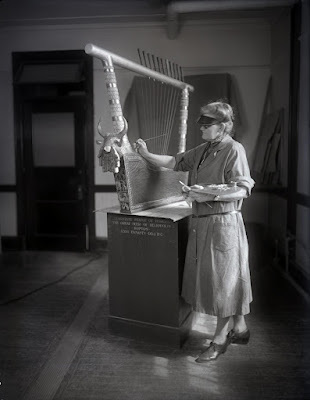
-~-
Your story is written in first person POV. What are the biggest benefits of this style of writing?
I heard an interesting statistic recently that only about 30 percent of people, according to psychologist Russell Hurlburt’s research, regularly think to themselves in internal monologues. I am in that camp and had no idea the majority of the population don’t have a running commentary in their minds at any given time of day. (Interestingly, I also think in images, which is, Hurlburt posits, what the other 70% do.) So the idea of writing an entire story from the perspective of an internal monologue is the most natural thing in the world to me. To do otherwise is really, really hard (and I’ve tried). What I have heard from readers of my stories who note the strengths of my writing, is that they feel united with my characters in very close, personal ways because there is an element of intimacy you can nurture as the narrator in first person. You can be as honest as you are willing to be with your audience. There is nowhere to hide.
-~-
Tiamat is a strong narrator. How did you come up with her as a character?
Tiamat is so much like most of the female main characters I write. I think she is probably an amalgamation of many parts of my own personality which is what made it so easy for me to write her. In the same way that so many actors get type cast for portraying the same type of character in their roles, I might be type cast as an author who writes this type of character almost exclusively. I’ll let the reader decide if that’s a good or bad thing.
-~-
Have you got a favourite line from A Našû for Ilu of which you felt particularly proud?
Yes, but without context it won’t mean anything. And unfortunately, the context would be a spoiler. The line itself isn’t a piece of brilliance but rather a “mic drop” in the story that was really satisfying to write. It will make sense once you read the story.
“Peace, dubsargal,” she said to my father without shifting her gaze from me. “Tiamat and I are old friends.”-~-What do you hope readers will take away from your story?

Whenever I talk with people about this story, or my research into Sumerian society, I often tell people that modern people would be shocked by the ancient world. I think it’s easy for us to look around our modern homes with our modern comforts and assume that no previous civilization could ever have had it as good as us. While that is true in many ways—it’s kind of hard to beat antibiotics—we also need to understand that their lives weren’t without comfort. There is some evidence that the people who lived “in the land between the rivers” had ways of cooling their homes!
I’m not saying I’d want to chuck it all and live back then, but I also think we need to set aside our notions of superiority and realize that ancient civilizations were more advanced than we give them credit. I hope readers get a taste of this.
-~-
If time travel were possible (perhaps it’s only a matter of time!) would you choose to go back to the 3rd Millennia BC or another time? Why?
Wouldn’t it be fun to go back and visit a point in time from history we have some fixed assumptions about only to see how far off we are in our certainty of those assumptions? I would LOVE to go back to the 3rd Millennia to test the historical theories that people much smarter than me have posited. But also, to test the most basic things, like is our timeline even right? I’d love to know if the living conditions of the cities, the quality of life, the climate, and their way of living is everything or nothing like we think it is. But I’d probably go back even farther in time because I have so many more questions to answer about pre-historic times than I can even begin to list here.
-~-
What’s next for your writing? Any projects in the pipeline?
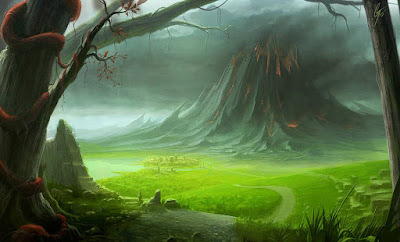
The reason I even began researching ancient Mesopotamia was for a fantasy trilogy inspired by the works of Stephen Lawhead, C.S. Lewis, and Plato (yes, the philosopher) I have been attempting to write for six or seven years. In fact, I’ve written the first book over again probably four times. The early versions were too abstract in setting, so I needed to find an era of history to use as an “anchor” to make the place and culture of my fantasy world understandable. After I completed all my research and rewrote again, I discovered I’d veered too far into historical. One of these days I’ll finish it.
You can find A Našû for Ilu in the Masterworks anthology, which is available on #KindleUnlimited HERE!

Now, let's meet the author!
 Stephanie Churchill is the author of three historical-feeling fiction novels, The Scribe’s Daughter, The King’s Daughter, and The King’s Furies, and one short story, Shades of Awakening, written for the Historical Writers Forum anthology, Hauntings. Her writing takes on a cadence that is sometimes literary, sometimes genre fiction, relying on deeply-drawn and complex characters while exploring the subtleties of imperfect people living in a gritty, sometimes dark world. Her unique blend of non-magical fantasy fiction inspired by true history ensures that her books are sure to please of historical fiction and epic fantasy literature alike. A Našû for Ilu is her first published work of historical fiction.
Stephanie Churchill is the author of three historical-feeling fiction novels, The Scribe’s Daughter, The King’s Daughter, and The King’s Furies, and one short story, Shades of Awakening, written for the Historical Writers Forum anthology, Hauntings. Her writing takes on a cadence that is sometimes literary, sometimes genre fiction, relying on deeply-drawn and complex characters while exploring the subtleties of imperfect people living in a gritty, sometimes dark world. Her unique blend of non-magical fantasy fiction inspired by true history ensures that her books are sure to please of historical fiction and epic fantasy literature alike. A Našû for Ilu is her first published work of historical fiction.Stephanie grew up in Lincoln, Nebraska. After graduating college with a degree in History and Political Science, she worked as an international trade and antitrust paralegal in Washington, D.C. She now lives with her husband, their two children, and two dogs in Minneapolis, Minnesota.
November 16, 2023
#HistFicThursdays - Harald Maddadsson - A Man Without Morals?
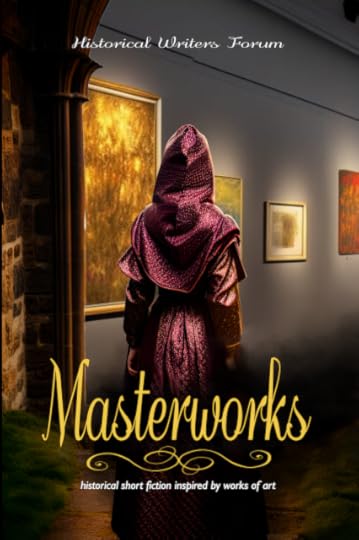
A couple of years ago, I wrote a blog about drawing inspiration from your local area. Two years on and here I am with a blog post about my latest published story, Proof of the Old Faith, which is one of the short stories in the Masterworks antholgy (which you can get here!). The story is based around the creation of the Maeshowe Dragon, a work of viking grafitti in Orkney, and it is one of the reliably documented outings of Harald Maddadsson [assuming the dragon dates from the second set of runes].
In Proof of the Old Faith, Harald in portrayed as a fearsome figure who the main character believes is the embodiment of the dragon Níðhöggr. In truth, Harald was certainly as frightening as a dragon, with the same fiery temper, and an equal tendency towards destruction.
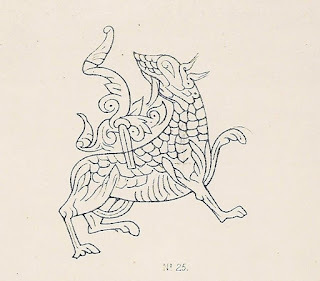 The Maeshowe Dragon
The Maeshowe DragonHarald had a mixed lineage, both Norse and Gaelic, and it was his mother's involvement with politics in Orkney which led him to claim a right to the jarldom. He had the longest tenure as Jarl of Orkney, and this is probably where his rather unimaginitive title "the Old" came from. During his 68 years in that position, he became good at making enemies and far less adept at forming alliances. He did, however, remain true to most of his family, and appears to have put all his focus in later years into preparing his sons for their roles. Sadly, they were to be the last Jarls in the Norse tradition, and the post was passed into Gaelic hands.
But, as well as being the Jarl of Orkney, Harald also had control of governing Caithness. This was a contentious area of land as, since it was joined on to the mainland, the Scottish king believed it should be under his control. And, it was on Caithnessian soil that Harald's most notorious deed was done, when he had the Bishop of Caithness' tongue and eyes removd simply because Bishop John argued against the collection of a Papal tax. Harald had a tumultuous relationship with the Catholic Church and this action only threw into a greater doubt what his personal beliefs might have been. Although this happened in 1201 (quite a long time after Proof of the Old Faith is set), it confirmed his lack of morals and scruples in light of religion. In fact, it seems quite likely that Harald believed himself to be God's equal.
[Bishop John's successor had far less qualms about taxing people, and ultimately Harald's son would be blamed for the murder of Bishop Adam when a group of yeomen boiled him in oil. Caithness has not had its own resident bishop since then.]
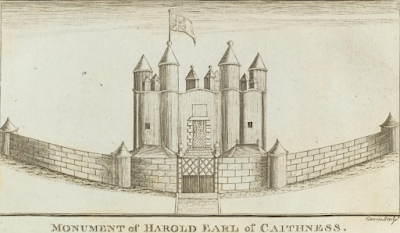 The Harold's Tower Folly
The Harold's Tower FollyHarald's life came to an end in 1206 from natural causes. He was pretty old by the standards of the day and he had certainly had an eventful life. But, although his life ended then, his story contninued. In the 1770s, an old direlict ruin of a chapel was ear-marked as the site of a new folly at Thurso East by the Earl of Caithness. A local minister and antiquarian, Alexander Pope, heard of this, and wrote to the landowner, cautioning him against dismanteling the chapel since it hald the remains of Jarl Harald. Dismissing the superstition, slightly spooked, but nonetheless determined to go ahead with his plans, the earl decided to style the folly as a mausoleum, no doubt theorising that this would give him the folly he wanted without disturbing the local population. A sign was placed on the building which read:
THE BURIAL PLACE OF THE SINCLAIRS OF ULBSTER
but the earl himself was buring in Edinburgh, and there is no record of any of the Sinclairs being buried there. Why, then, was a report issued in the 20th century, almost 800 years after Harald's death, about a vault being broken into and "coffins displaced". Perhaps Rev Pope was right and Harald was there. But, with the supposed bodies gone, there could be no testing to find out who they had been.
So, for now, Harald's burial place and remains are still hidden. Perhaps that is the price he pays in death for his infamy in life.
November 8, 2023
#HistFicThursdays - Masterworks - The Maeshowe Dragon as Inspiration for "Proof of the Old Faith"
There are no stories which stick with you more than those from childhood. My childhood was full of stories: myths and legends abounded and tales of Finn Folk, or medieval battles fought with a stone in a sock (I know, I know, it wasn't quite like that, but this was the bit which stuck with me as a child!), were always on hand in the landscape. It was exciting to drive past the locations of Summerdale at the back of the house we used to live in, or to see Eynhallow which Thorodale made visible when he defeated the Finn Folk. But it was still somehow distant and difficult to relate back to those warriors and characters of days gone by.
But imagine, as a child, seeing a message left by someone eight hundred years ago - of blizzards and crusaders. Or better still: a picture they left behind...
Cue: The Maeshowe Dragon
Stenness, where I spent my early childhood, is seeped in history. It has standing stones and henges which date back into the third millennia BC, and ancient mounds and settlements which remain an enigma today. Tantalising, but difficult to connect with.
Then - after many other inhabitants on the islands - came the Vikings. Invaders, plunderers, and then settlers, the legacy of the Norse race on Orkney is incredible, not least because of the written accounts they left. And this was something I could relate to. Here was that man who scrawled obscenities onto stones, the gangs who egged each other on to enter dark caverns on a dare, the boastful comments about being the tallest or reaching furthest to carve their names... Not a lot has changed in the world of graffiti!
And, in amongst all that, was a picture of a creature. A dragon, perhaps? A dog? A hare? A griffon? Who knows, for there is nothing in the carvings which explains why he is there.
This little beast has been a mystery for me since those early days so, when the Historical Writers Forum decided to put together an anthology based on artwork, it had to be about him. We know from the sagas that it was Jarl Harald and his men who broke into Maeshowe during a blizzard, and he was quite a character - but, to find out about him, you'll have to wait until next week.
So, please check out this homage to my childhood mystery. Proof of the Old Faith is the second story in Masterworks, and is inspired by the carving of the Maeshowe Dragon. It is written with a great deal of love and affection for my old home.
And, as always, please leave a review to let me know what you thought!
You can get Masterworks on #KindleUnlimited here!
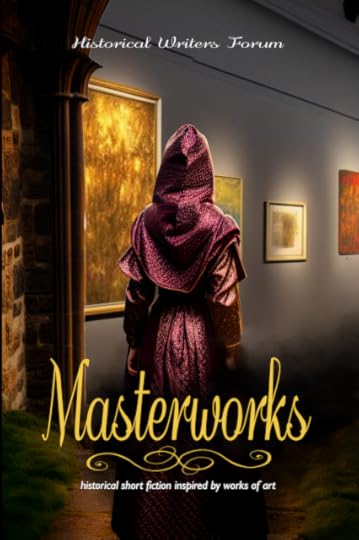
Strolling through an art gallery gives art appreciators a glimpse at the heart of creativity artists from across time and distance have poured onto canvas, into clay, through wood, metal, and stone. Art inspires us and helps us connect with emotions and ideas. But have you ever wondered what inspired the artists themselves? Perhaps it was a loved one, a moment of suffering or despair, a celebration, or a victory. Have you ever wondered what stories these works tell?
We asked the authors of the Historical Writers Forum these questions, to imagine what stories might be revealed in the history of famous works of art. Through their short stories, you will be transported back in time to the magnificence of works of art from ancient Mesopotamia to nineteenth century America, exploring the people, events, and emotions that may have inspired incredible works of art.
This anthology from Historical Writers Forum includes the following short stories:
A Našû for Ilu
Stephanie Churchill
Proof of the Old Faith
Virginia Crow
La Belle Dame sans Merci
Kathleen Guler
Blood on White Mountain
Eleanor Swift-Hook
The Lacemaker’s Son
Melissa Speed
The Portrait
Lars D.H. Hedbor
The Ambassadress
Ronan Beckman
A Good and Proper Lunacy
Tempest Wright
Portrait of a Lady
Joanne Major
The Watcher on the Wall
Gareth Williams
Legacy
Samantha Wilcoxson
November 1, 2023
#HistFicThursdays - Who She Left Behind - Victoria Atamian Waterman - Book Excerpt

There's a real treat for you here this week for #HistFicThursdays! I'm once again teaming up with The Coffee Pot Book Club for author Victoria Atamian Waterman's blog tour! Today, I'm sharing an excerpt from her fabulous book, Who She Left Behind!
First of all, let's meet the book...
Who She Left Behind is a captivating historical fiction novel that spans generations and delves into the emotional lives of its characters. Set in various time periods, from the declining days of the Ottoman Empire in Turkey in 1915 to the Armenian neighborhoods of Rhode Island and Massachusetts in the 1990s, the novel completely immerses its reader in a lesser-known era and the untold stories of the brave and resilient women who became the pillars of reconstructed communities after the Armenian Genocide.
It is a story of survival, motherhood, love, and redemption based on the recounted stories from the author’s own family history. The narrative is framed by a mysterious discovery made almost six decades later of a pair of Armenian dolls left at a gravesite.
You can buy Who She Left Behind via these Universal Links: Hardback & eBook
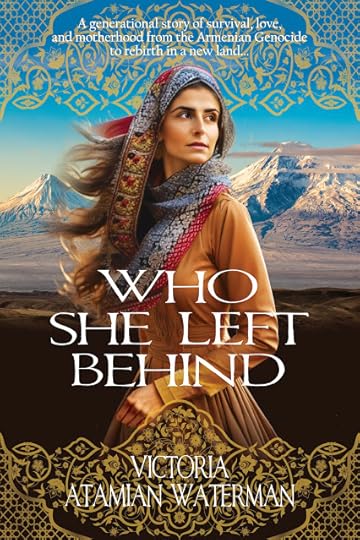
And here's an excerpt to whet your appetite:
The night before Lucy's wedding, Vicky crawled into bed long after midnight, sore and chilled, but the dress and veil were finished and pressed, waiting on a hanger for the bride to arrive before church in the morning. “You give us all so much, my love,” Pesa whispered into the dark. “I hope your sister knows how fortunate she is in you.” Vicky kissed her husband’s shoulder and lay still while his breathing slowed, and he slipped back into sleep. Her heart banged against her chest, as though all her secrets might burst from her chest. I failed everyone who needed me most. I failed my living child. I lost her forever. I lied to everyone I loved and hid her from the world. I failed our baby girl. My body wasn’t strong enough to keep her alive. I failed you, my love. Rolling over, Vicky let her silent tears soak into the pillowcase. She would not fail Lucy and that would make up for all the secrets.
Now, let's meet the author:
 Victoria Atamian Waterman is an Armenian American storyteller and speaker who draws inspiration from the quirky multigenerational, multilingual home in which she was raised with her grandparents, survivors of the Armenian Genocide.
Victoria Atamian Waterman is an Armenian American storyteller and speaker who draws inspiration from the quirky multigenerational, multilingual home in which she was raised with her grandparents, survivors of the Armenian Genocide.Her empowerment of today’s women and girls makes her voice ideal for telling the little-known stories of yesterday’s women leaders. Her TED Talk, Today’s Girls are Tomorrow’s Leaders has been seen by thousands of viewers. When she is not writing and speaking, she is reading, puzzle-making and volunteering.
Victoria lives in Rhode Island and is enjoying this next chapter of life with her husband, children, and grandchildren. Who She Left Behind is her first novel.
You can find Victoria on these links:
To follow the rest of the Who She Left Behind tour, click on the banner below:
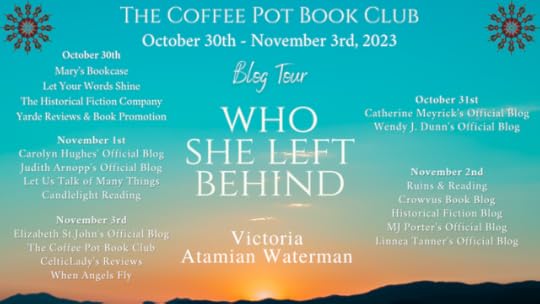
October 31, 2023
NEW RELEASE: Masterworks - short stories inspired by works of art
Today is very exciting! It is the launch day for the fabulous third anthology from the Historical Writers Forum. Ladies and gentlemen, welcome to
MASTERWORKSThis anthology is comprised of eleven stories from writers of HWF, and range from the 3rd Millenia BC to the 20th Century, each one inspired by a piece of artwork. Keep scrolling to meet the authors involved as well as their chosen artwork, but first of all, let's meet the book...
Blurb
Strolling through an art gallery gives art appreciators a glimpse at the heart of creativity artists from across time and distance have poured onto canvas, into clay, through wood, metal, and stone. Art inspires us and helps us connect with emotions and ideas. But have you ever wondered what inspired the artists themselves? Perhaps it was a loved one, a moment of suffering or despair, a celebration, or a victory. Have you ever wondered what stories these works tell?
We asked the authors of the Historical Writers Forum these questions, to imagine what stories might be revealed in the history of famous works of art. Through their short stories, you will be transported back in time to the magnificence of works of art from ancient Mesopotamia to nineteenth century America, exploring the people, events, and emotions that may have inspired incredible works of art.
You can find Masterworks on #KindleUnlimited here!
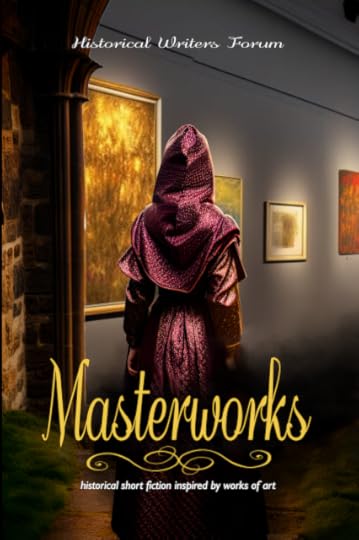
This anthology from Historical Writers Forum includes the following short stories:
A Našû for Ilu
Stephanie Churchill
Proof of the Old Faith
Virginia Crow
Kathleen Guler
Blood on White Mountain
Eleanor Swift-Hook
Melissa Speed
The Portrait
Lars D.H. Hedbor
Ronan Beckman
A Good and Proper Lunacy
Tempest Wright
Joanne Major
The Watcher on the Wall
Gareth Williams
Samantha Wilcoxson
Keep checking back over the month to find each author's blog about their chosen artwork, their guest blogs, and a Q&A post.
Now let's meet the authors!
 Stephanie Churchill
Stephanie ChurchillStephanie Churchill is the author of three historical-feeling fiction novels, The Scribe’s Daughter, The King’s Daughter, and The King’s Furies, and one short story, Shades of Awakening, written for the Historical Writers Forum anthology, Hauntings. Her writing takes on a cadence that is sometimes literary, sometimes genre fiction, relying on deeply-drawn and complex characters while exploring the subtleties of imperfect people living in a gritty, sometimes dark world. Her unique blend of non-magical fantasy fiction inspired by true history ensures that her books are sure to please of historical fiction and epic fantasy literature alike. A Našû for Ilu is her first published work of historical fiction.
Stephanie grew up in Lincoln, Nebraska. After graduating college with a degree in History and Political Science, she worked as an international trade and antitrust paralegal in Washington, D.C. She now lives with her husband, their two children, and two dogs in Minneapolis, Minnesota.
Virginia Crow is a Scottish author who has a passion for historical fiction on the cusp of the supernatural. Her book The Year We Lived won the Supernatural Historical Fiction Prize in the 2022 Coffee Pot Book Club Awards. When not writing, Virginia is usually to be found teaching music or walking her spaniels, Orlando and Jess.
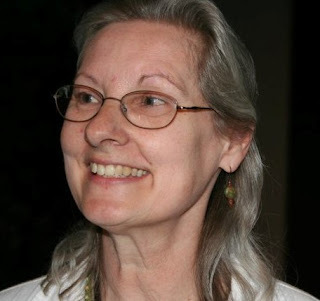 Kathleen Guler
Kathleen GulerKathleen Guler is the author of the multi-award winning Macsen’s Treasure Series: four historical novels set in fifth-century Arthurian Britain. The series includes A Land Beyond Ravens, which won the 2010 Colorado Book Award in the historical fiction category. The author has also published numerous articles, essays, short stories, reviews, and poems. Her work has appeared in Goose River Press, Eastern Iowa Review, Steamboat Magazine, and Saber and Scroll Journal, among other publications. She is a member of the Colorado Authors League and the Historical Novel Society. Her fifth novel intertwines a trio of stories revolving around a tough warrior-priestess in ancient nomadic Scythia, an impulsive, headstrong widow on the run in early medieval Europe, and a suicidal female archaeologist in late nineteenth-century Britain. The author lives in the magnificent Colorado Rocky Mountains with her husband, two parakeets, and probably what amounts to the entire county’s bird population.
Eleanor Swift-Hook enjoys the mysteries of history and fell in love with the early Stuart era at university when she re-enacted battles and living history events with the English Civil War Society. Since then, she has had an ongoing fascination with the social, military and political events that unfolded during the Thirty Years’ War and the Wars of the Three Kingdoms. She lives in County Durham and loves writing stories woven into the historical backdrop of those dramatic times.
 Melissa Speed
Melissa SpeedMelissa Speed writes fiction and poetry in addition to her creative non-fiction, personal essays and travel blogging. Much of her work is published on Medium in a variety of publications, including the popular Scribe. Her personal essay I Was Ashamed of My Post-Surgery Body Hair was published in Issue 1 of Aghh! Zine (2022, Brighton, UK). Her historical poem Queen of the Iceni (published in Medium's Share the Love, June 2020) was adapted into a choral work by the American choir Pantera, and she is the winner of a Kids Poetry Club poetry for children competition. She writes a history-themed disabled travel blog at
http://www.accessinghistory.com.
In addition to her writing, Melissa has previously been a beta reader for several historical fiction authors. A volunteer for two heritage trusts, she is also an artist and an avid reader in her spare time.
She lives in Buxton, Derbyshire in the UK.
Lars D. H. Hedbor is the leading novelist of the American Revolution, as well as being an amateur historian, linguist, brewer, cuckoo clock restorer, fiddler, astronomer and baker. Professionally, he is a technologist, high school foreign exchange coordinator, marketer, writer, and father. His love of history drives him to share the excitement of understanding the events of long ago, and how those events touch us still today.
 Ronan Beckman
Ronan BeckmanRonan Beckman is an American educator who has lived in the UK for over 30 years. He has a wife and daughter at home, who he is immensely dependent upon for feedback and editing of his writing. His interest in history and genealogy helped to spark an interest in further developing the stories of some of the family he researched - resulting in his debut novel An Actress of Repute. Subsequently, he has become a bit obsessed with all things Georgian and Regency related. In addition to fiction based on historical biography, Ronan is working on editing the works of a coal miner who became a Member of Parliament, and gathering information for a planned biography of a French cartoonist who was the roommate and collaborator of a young Mark Twain.
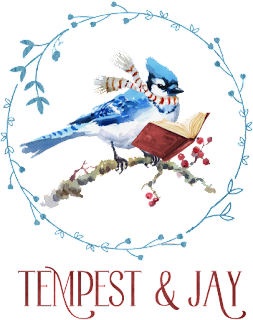 Tempest Wright
Tempest WrightTempest Wright is an author of historical fiction and fantasy, though she's been known to dabble in sci-fi and poetry. Living amongst the beautiful scenery of Vancouver Island, Canada, she finds inspiration in nature, music, and the people who come her way. This includes the love of her supportive husband, and the cuddles of two cats who have a playful fascination with her keyboard.
Tempest enjoys a strong, character-driven story, which should always be had with an equally good cup of tea. She aspires to create characters and plots that inspire her readers and immerse them into both her historical and fantastical worlds.
History often leaves gaps, and places where Tempest can weave a story, and it’s these gaps she loved embellishing in A Good and Proper Lunacy.
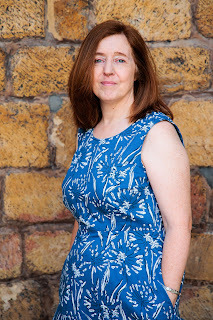 Joanne Major
Joanne MajorJoanne Major is the author, and co-author, of several works of historical nonfiction published by Pen & Sword History, set mainly in the Georgian era. Her latest book is the biography of an eighteenth-century courtesan whose name is remembered in a nursery rhyme, Kitty Fisher: The First Female Celebrity. Joanne holds a BA (First Class) in Creative Writing from the University of Lincoln and is studying for an MA in the same, focusing on crime/thriller writing. She lives in Lincolnshire with her family and dogs.
I studied History and Law at Queens’ College, Cambridge before briefly working in banking and recruitment. I eventually settled on a very happy career in teaching.
I taught history at Elizabeth College, Guernsey and was then head of department at The School of St Helen & St Katharine, Abingdon. Finally, I was Director of Sixth Form at St Mary’s, Ascot.
I retired to the Isle of Skye where I am climbing all the Scottish mountains over 3000 feet. In winter, I try to ski as much as possible, both backcountry and downhill.
My first novel, Needing Napoleon, was published in November 2021. My main character is instrumental in helping Napoleon rebound after his defeat at Waterloo, ultimately helping him escape from St Helena for the shores of Africa. The sequel, Serving Shaka, came out in March 2022. In this book, Napoleon encounters the growing might of the Zulu nation and has to accommodate himself to a very different reality. I have completed the third instalment of The Richard Davey Chronicles, which is titled Rescuing Richard. This should be released in spring 2023.
I am working on a standalone historical adventure set during and immediately after the American War of Independence. I am also pondering the ending of a ghost story that weaves together three timelines that converge on Hadrian’s Wall.
I have written short stories on a variety of subjects. Most recently, I wrote a short story featuring a nineteenth century photographer. This was part of a collaborative project with a friend who has built a wet-plate collodion camera.
I give talks in my local area and beyond as well as participating in an online history writers’ group. I am chairperson of The Skye Reading Room, a local organisation for both readers and writers. I am a member of the Scottish Writers’ Association and the Historical Novel Society. I have applied to the Scottish Book Trust to join their Live Literature scheme and will be attending the Scottish Writers’ Association Conference 2023 near Glasgow in March.
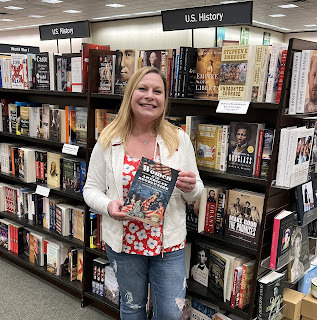 Samantha WilcoxsonSamantha Wilcoxson is the author of historical fiction and nonfiction, an administrator for the Historical Writers Forum, and history blogger.
Samantha WilcoxsonSamantha Wilcoxson is the author of historical fiction and nonfiction, an administrator for the Historical Writers Forum, and history blogger.https://samanthawilcoxson.blogspot.com/
She lives in Michigan with her husband of twenty-eight years and is the mom of three amazing young adults. Samantha loves exploring the emotional side of history and visiting historic places to feel closer to the past.
October 25, 2023
#HistFicThursdays - If It's the Last Thing I Do - David Fitz-Gerald - Book Excerpt
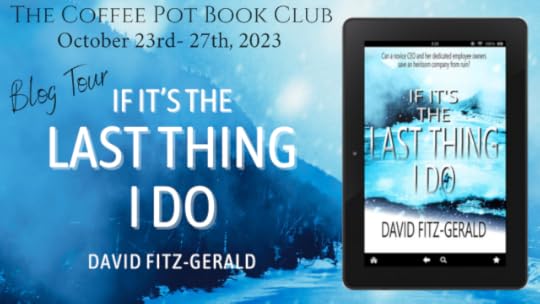
This week for #HistFicThursdays, I'm delighted to once again be teaming up with The Coffee Pot Book Club for author David Fitz-Gerald's blog tour! Today, I'm sharing an excerpt from his brilliant book, If It's the Last Thing I Do!
First of all, let's meet the book...
It's 1975, and Misty Menard unexpectedly inherits her father's business in Lake Placid, New York. It never occurred to her that she could wind up as the CEO of a good old-fashioned manufacturing company.
After years of working for lawyers, Misty knows a few things about the law. Her favorite young attorney is making a name for himself, helping traditionally owned companies become employee owned, using a little-known, newly-passed law. When he offers to help Misty convert Adirondack Dowel into an ESOP, pro bono, Misty jumps at the chance.
The employees are stunned, the management team becomes hostile, and the Board of Directors is concerned. Misfortune quickly follows the business transformation. A big customer files for bankruptcy. A catastrophic ice jam floods the business. Stagflation freezes the economy. A mysterious shrouded foe plots revenge. Misty's family faces a crisis. The Trustee is convinced something fishy is going on, the appraiser keeps lowering the company's value, and the banker demands additional capital infusions. Misty thought she had left her smoking addiction and alcoholism in the past, but when a worker's finger is severed in an industrial accident, Misty relapses.
Disasters threaten to doom the troubled company. After surviving two world wars and the Great Depression, it breaks Misty's heart to think that she has destroyed her father's company. All she wants is to cement her father's legacy and take care of the people who built the iconic local business. Can a quirky CEO and her loyal band of dedicated employee owners save an heirloom company from foreclosure, repossession, and bankruptcy?
Get your copy of the thrilling If It's the Last Thing I Do now... if it's the last thing you do!
You can buy If It's the Last Thing I do via this Universal Link
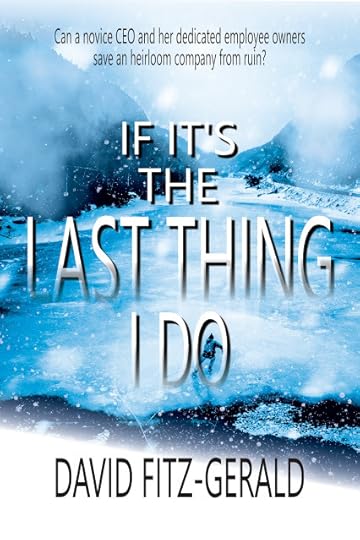
And here's an excerpt to whet your appetite:
Stuart, Art, and Doyle promptly took their regular seats and I greeted the team as Joanne stepped into the room. We had been meeting dutifully every Monday for a year, but the gathering still felt as uncomfortable as the first one did. The men didn't argue about whether they should attend the meetings and they didn't discuss whether any value came from our meetings. Instead, they endured them. Whether they had discussed it, or it just turned out that way, one thing they seemed to agree upon was a strategy of running out the clock. It was always up to me to have discussion topics ready, or we would sit in silence waiting for the time to expire.
I thought about all the questions that Benjamin asked me during his valuation interview over a month ago, and that helped me think of new topics to discuss with the group. After each man gave his update and answered my questions, I took a deep breath. I looked at each man for a moment, finally resting my gaze on Doyle. All weekend, I rehearsed the words I would use when we met today.
My eyes closed for a second and I thought of Father. I wish that he were here to witness the gift I was about to bestow upon his workers, in his name. "I've decided to sell the company to the workers. The sale will happen over the course of several years, and the first transaction will happen on Independence Day. I plan to hold a big luncheon on Friday to tell everyone the big news, so I want you to keep it to yourselves until then. Maybe you've never heard of ESOPs, but under a new law, employees can become owners through an Employee Stock Ownership Plan."
Doyle was the first to speak. "What kind of an idiot are you?" Truthfully, the man added an expletive before the word idiot.
Thanks to Art, I didn't have to categorize for Doyle just what sort of an idiot I was. The business manager said, "Why would you go and do a thing like that?"
Stuart's perpetual grin became a guffaw and he slapped his thighs. "Doesn't that beat all? What will you think of next, Misty?"
Doyle added. "That'd be like putting the students in charge of the high school. How can you expect the principal to do his job?"
Art added, "Or putting the prisoners in charge of the jail. What's the warden to do?"
Stuart laughed and held his sides like it hurt to have to laugh so hard. "Oh, or like opening all the cages at the zoo and expecting the animals not to eat each other." I looked at the sales manager and imagined a lion chewing on his carcass.
Doyle said, "Next thing you know it, Misty'll want everyone to sit around in a meeting, holding hands, and singing songs."
Stuart began singing, "I'd like to Teach the World to Sing (In Perfect Harmony)." I smiled at the thought and the five-year-old song played in my head.
The door between the factory and the office swung open and Millie shouted, "Come quickly. There's been a terrible accident. Call an ambulance."
Now, let's meet the author:
 David Fitz-Gerald writes historical fiction in his spare time, with the hope of transporting readers to another time and place.
David Fitz-Gerald writes historical fiction in his spare time, with the hope of transporting readers to another time and place.If It's the Last Thing I Do is his 7th novel.
Dave has worked for more than 30 years as an accountant, employee owner, and member of the management team at a "silver" ESOP (employee-owned) company. He has championed the cause in national, non-profit association leadership roles.
Dave’s family roots run deep in the Adirondacks, going back generations. He attended college and worked at a deli in Saranac Lake during the 1980s. He spent two summers as an elf at Santa’s Workshop on Whiteface Mountain in the 1970s and is an Adirondack 46-er, which means he has hiked all of New York’s highest peaks.
You can find David on these links:Link Tree - Website - Twitter - Facebook - LinkedIn - Instagram - Pinterest - Amazon - Goodreads - Soundtrack on SpotifyTo follow the rest of the If It's the Last Thing I Do tour, click on the banner below:
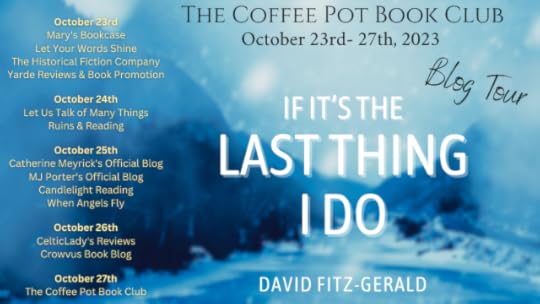
October 18, 2023
#HistFicThursdays - Burning Secret - R J Lloyd - Guest Post
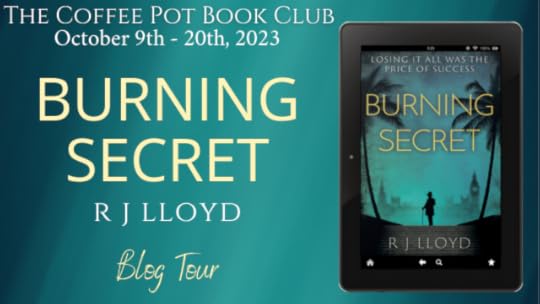
It's #HistFicThursdays, and I'm delighted to offer you a fabulous guest post from R J Lloyd, as part of his Coffee Pot Book Club tour. Discover the personal nature of this book, and why the author chose to tell Enoch's story in Burning Secret. But first, let's meet the book...
Inspired by actual events, Burning Secret is a dramatic and compelling tale of ambition, lies and betrayal.
Born in the slums of Bristol in 1844, Enoch Price seems destined for a life of poverty and hardship-but he’s determined not to accept his lot.
Enoch becomes a bare-knuckle fighter in London’s criminal underworld. But in a city where there’s no place for honest dealing, a cruel loan shark cheats him, leaving Enoch penniless and facing imprisonment.
Undaunted, he escapes to a new life in America and embarks on a series of audacious exploits. But even as he helps shape history, Enoch is not content. Tormented by his past and the life he left behind, Enoch soon becomes entangled in a web of lies and secrets. Will he ever break free and find the happiness he craves?
Influenced by real people and events, Enoch’s remarkable story is one of adventure, daring, political power, deceit and, in the end, the search for redemption and forgiveness.
Burning Secret is available via this Universal Link.
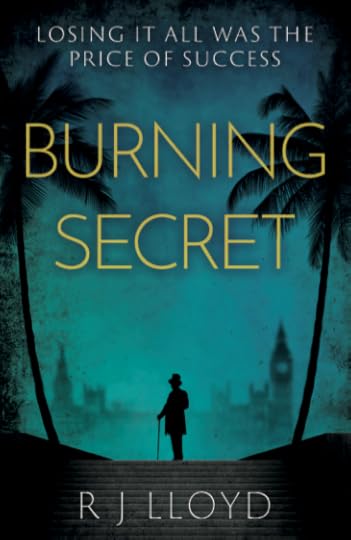
Guest Post
After retiring as a senior police officer, I turned my detective skills to genealogy, tracing my family history to the 16th century. However, after 15 years of extensive research, I couldn't track down my great-great-grandfather, Enoch Price, whose wife, Eliza, had, in living memory, helped raise my mother.
As a young girl, my mother could only remember hushed conversations about her nan's husband, Enoch, going to Florida to open a corset factory.
In June 2011, my cousin Gillian, a skilled family history researcher, after several dead-ends, called to say that she had found him through a fluke encounter. Susan Sperry from California, who had recently retired, decided to explore the box of documents given to her thirty years before by her mother, which she had never opened. In the box, she found references to her great-grandfather, Harry Mason, a wealthy hotel owner and powerful American politician from Jacksonville, Florida, who had died in 1919. It soon transpired that Susan's great-grandfather, Harry Mason, was, in fact, Enoch Price. From this single thread, the extraordinary story of Harry Mason began to unravel, leading me to visit the States to meet my American cousins. It was Susan Sperry and Kimberly Mason, direct descendants, who persuaded me to write Burning Secret, not as a biography, but as a thriller, merging fact with fiction, to tell the story of the extraordinary adventurer, rogue and chancer that he was.
Burning Secret took another eleven years to research and write, and sadly, both Susan and Kimberly passed away before the novel was complete.
The more I researched, the more I realised how much more I needed to explore. Enoch is listed in the London Gazette as a bankrupt and was bound for two in the debtors' prison, from which few emerged unscathed. Abandoning his wife and three young daughters, he made for Florida. It was here, in Jacksonville, that he carved out his future, and, by hook or by crook, he amassed a fortune and became a powerful politician. While all of this time, his wife, Eliza, and daughters languished in poverty in the slums of Bristol, England.
Harry played a historically significant role in Jacksonville, arriving in 1881, only sixteen years after the end of slavery and the American Civil War, when Florida had fought on the defeated Confederate side. In 1888, Jacksonville was decimated by a deadly outbreak of Yellow Fever, and in 1901, the city was razed to the ground by the Great Fire of Jacksonville. Harry played a pivotal role in each of these catastrophes. Yet, undaunted, he was the promoter who, against fierce public opposition, brought the 1894 World Heavyweight Boxing Championship fight between Gentleman Jim Corbett and Charlie Mitchell to Jacksonville. His most outstanding achievement was building the Hotel Mason, Jacksonville, on the junction of Bay and Julia, which opened on 31 December 1913. The largest and most opulent hotel in Florida (demolished in 1978).
Surprisingly, whilst many of Harry's friends, business partners and historically important contemporaries are recorded in Jacksonville to this day, one must dig very deep into obscure records to find his name, and only one photograph of him survives, taken in 1903 when he was elected to the House of Representatives.
Harry is buried alongside his American wife at Evergreen Cemetery, Jacksonville, Florida.
Now, let's meet the author:
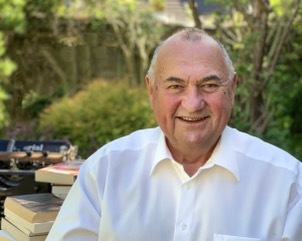 After retiring as a senior police officer, R J Lloyd turned my detective skills to genealogy, tracing his family history to the 16th century. However, after 15 years of extensive research, he couldn’t track down his great-great-grandfather, Enoch Price, whose wife, Eliza, had, in living memory, helped raise his mother.
After retiring as a senior police officer, R J Lloyd turned my detective skills to genealogy, tracing his family history to the 16th century. However, after 15 years of extensive research, he couldn’t track down his great-great-grandfather, Enoch Price, whose wife, Eliza, had, in living memory, helped raise his mother.It was his cousin Gillian who, after several more dead-ends, called one day to say that she had found him through a fluke encounter. Susan Sperry from California, who had recently retired, decided to explore the box of documents given to her thirty years before by her mother, which she had never opened. In the box, she found some references to her great grandfather, Harry Mason, a wealthy hotel owner from Florida who had died in 1919. It soon transpired that Susan’s great grandfather, Harry Mason, was, in fact, Enoch Price.
From this single thread, the extraordinary story of Harry Mason began to unravel, leading R J Lloyd to visit the States to meet his newly discovered American cousins, and it was Susan Sperry and Kimberly Mason, direct descendants, who persuaded R J Lloyd to write the extraordinary story of their ancestor.
R J Lloyd graduated from the University of Warwick with a degree in Philosophy and Psychology and a Masters in Marketing from UWE. Since leaving a thirty-year career in policing, he’s been a non-executive director with the NHS, social housing, and other charities. He lives with my wife in Bristol, spending his time travelling, writing and producing delicious plum jam from the trees on his award-winning allotment.
You can find him on these links:Website - Twitter - Facebook - Instagram - Amazon Author Page - GoodreadsKeep up with the rest of the tour stops for Burning Secret by clicking on the banner below:
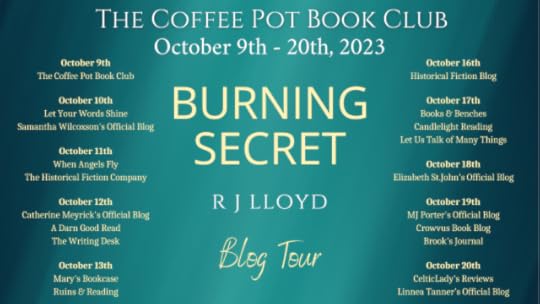
Crowvus Book Blog
- Virginia Crow's profile
- 128 followers


